Why the Wall Won't Work
The legal, practical, economic, and moral case against Trump's border barrier.
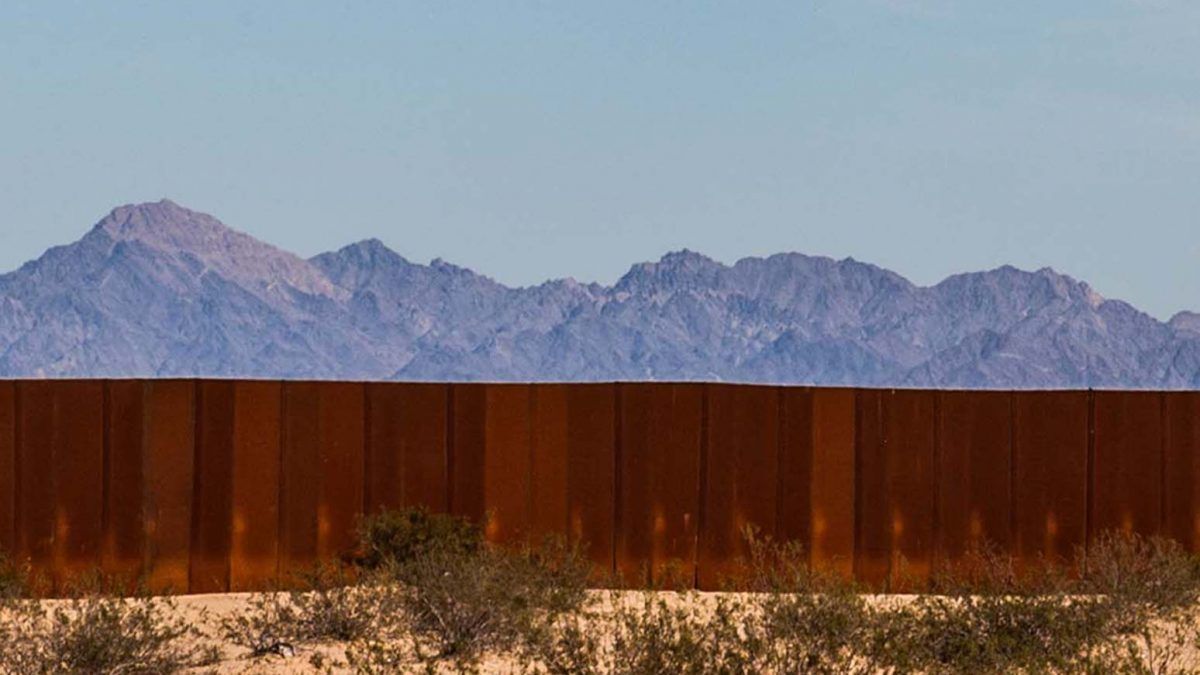
Donald Trump captured the imagination of many American voters with a single campaign promise. "I will build a great, great wall on our southern border," he boasted in June 2015. For good measure, he added, "And I will have Mexico pay for that wall." The twin pledges—which followed a tirade about Mexican rapists and drug dealers—neatly captured everything that was either attractive or repulsive to voters in the real estate mogul's presidential run: bravado, nationalism, and controversy.

Trump was often criticized for lacking precision in policy ideas, but he had bold and detailed requirements for his wall. It would be 1,000 miles long. (The other 1,500, he said, were covered by "natural barriers.") He gave various estimates of its height—between 30 and 50 feet, with the most common number being 35. His barrier would be an "impenetrable physical wall" composed of "precast [concrete] plank…30 feet long, 40 feet long." He also insisted that it would be aesthetically pleasing.
While he said after the election that a fence may be appropriate in "some areas," he added that a wall would be better, and he has since vigorously corrected reporters who describe the project as a "fence." Throughout the campaign, he described the current fences as a "joke," implying that he would not only build a superior barrier, but that he would replace the one that exists at some points now.
The History The president's proposal has a decadeslong history. After the 1986 "amnesty," when President Ronald Reagan traded increased border security for the legalization of 3 million unauthorized immigrants, the San Diego Border Patrol constructed a 10-foot welded steel fence along the 14-mile section of the border closest to the Pacific. In 1996, a new law provided funds for a second layer. Despite repeated requests from the Border Patrol for more, by the year 2000 just 60 miles of the southern border had fencing, almost all of which was in urban areas. Only San Diego had a second layer.
After 9/11, border hawks launched another push for fences, with little success. Most immigration enforcement funds were going to a surge in border agents. But President George W. Bush's push for comprehensive immigration reform, which would have legalized the unauthorized immigrants in the United States, gave the hawks their opportunity. In 2006, Congress approved the Secure Fence Act mandating nearly 700 miles of fencing on the border.
The president signed on to the bill hoping to placate the secure-the-border-first crowd and obtain the humane immigration changes that he wanted. This sales job enabled it to pass with bipartisan support from the likes of Barack Obama and Hillary Clinton. The immigration reform never materialized, but fence construction was nearly complete by 2009, and there are now 617 total miles of physical barriers, 36 miles of which have two layers.
Yet the hawks were not placated. They complained that there was no second layer in most places. They stewed that half the fence was just "vehicle barriers"—concrete posts that provide obstacles for drivers but not pedestrians. Moreover, the 317 miles of real pedestrian fences dramatically vary in height and quality. The Border Patrol uses half a dozen types of fencing materials—wire mesh, landing mats, chain-link, bollard, aesthetic, and sheet piling—just to control on-foot crossings. These barriers are mainly a combination of steel posts and bars supplemented in places with wire, ranging in height from 6 to 18 feet.
The Legal Obstacles Trump has been adamant that his wall will be built "ahead of schedule." For that to happen, he'll need to avoid the various legal issues that plagued earlier efforts. Entities other than the federal government—states, Indian tribes, private individuals—control over two-thirds of borderland property. Private parties own the vast majority of the border in Texas, and for this reason, roughly 70 percent of the existing border fence is located in California, Arizona, and New Mexico. Almost all of it is on federally controlled land.
The Bush administration bullied property owners, threatening to sue them if they did not "voluntarily" hand over the rights to their land. It offered no compensation for doing so. Thinking that they had no recourse, some people signed off, but others refused. The government then attempted to use eminent domain, a procedure Trump has long defended, to seize their property, but the lawsuits imposed serious delays—seven years in one case.
In 2009, the Homeland Security inspector general concluded that the Border Patrol had "achieved [its] progress primarily in areas where environmental and real estate issues did not cause significant delay." One intransigent resident had owned his property since before the "Roosevelt easement," which gives the federal government a 60-foot right of way along the border. He fought the administration, so the fence had until recently a 1.2-mile gap on his land. Border residents fought more than a third of all land transfers, in fact. Because the Constitution promises just compensation for takings, Trump can do little to speed this process.
Native American tribes also have the capacity to stop construction of barriers. The Tohono O'odham Nation, which has land on both sides of the border, has already pledged to fight any efforts to build a wall there. In 2007, when the tribe allowed vehicle barriers to be constructed, the Bush administration ended up desecrating Indian burial grounds and digging up human remains. The new president would need a stand-alone bill from Congress to condemn their land. Senate Democrats can (and likely would) filibuster such an effort.
Even federal lands can be problematic. In 2010, two-thirds of patrol agents-in-charge told the Government Accountability Office (GAO) that land management laws had delayed or limited access to portions of federal lands, for fence building or repairs and other purposes, with more than half stating they did not get a timely response when they requested permission to use the lands. In one case, it took nearly eight months for the Border Patrol to get the OK to install a single underground sensor.
Water rights have also been a problem for the fence. A 1970 treaty requires that the floodplain of the Rio Grande remain open to both sides of the border. The Obama administration attempted to build fences along the river anyway, but the treaty and the river's floods forced the barrier to be placed so far into the interior of the United States that it has many holes to allow U.S. residents access to their property. These also provide an opportunity for border crossers.
At the same time, the fence can cause Mexico to receive too much water. Even when a fence has holes, which a wall would not, debris can turn the fence into a dam. Thanks to the barrier, some floods have fully covered the doors of Mexican buildings in Los Ebanos, across the Rio Grande, while producing little more than deep puddling on the U.S. side. The International Boundary and Water Commission that administers the treaty has rebuffed the Border Patrol's attempts to replicate this disaster in other areas of the Rio Grande Valley.
The Practical Considerations Fences or walls obstruct crossers' paths, cutting off a straight shot into the interior of the country. But a barrier is not the permanent object that some people imagine. Natural events can knock down parts of a border fence. One storm in Texas left a hole for months. Fences and walls can also erode near rivers or beaches, as the one in San Diego did. And they can be penetrated: Some fencing can be cut in minutes, and the Border Patrol reported repairing more than 4,000 holes in one year alone. They neglected to mention whether that number equaled that year's number of breaches.
Much of the current fencing can be easily mounted with a ladder or from the roof of a truck. In some cases, border crossers can scale the fence without any additional equipment. One viral video from 2010 shows two women easily climbing an 18-foot steel bollard-style pedestrian fence in less than 20 seconds. Smugglers can even drive over the fence using ramps, a fact that was discovered only when a couple of foolish drug entrepreneurs managed to get their SUV stuck on top. (They took the dope and split.)
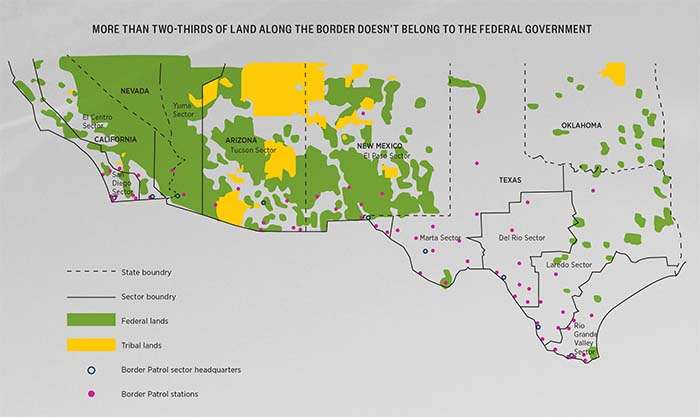
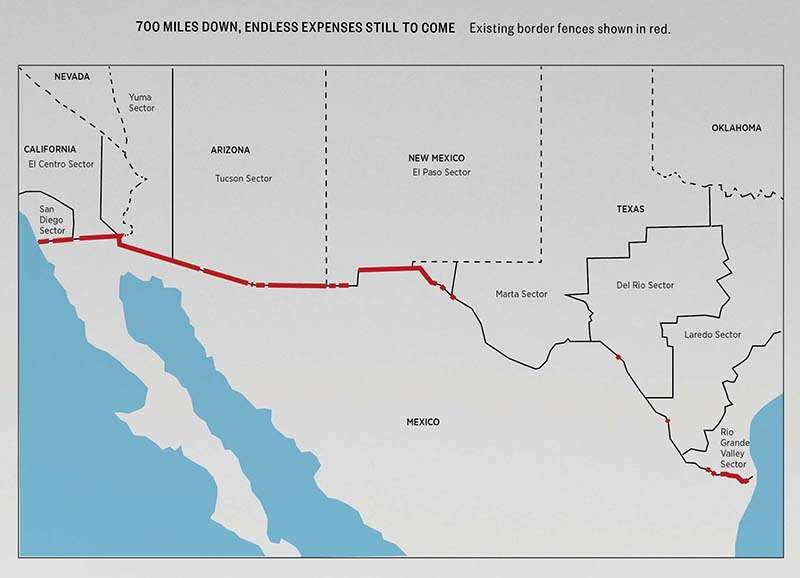
A wall would probably be less easily damaged by man or nature. But in at least some areas, its impassibility could also become a maintenance liability. Border Patrol agents have told Fox News that a border wall would still "have to allow water to pass through, or the sheer force of raging water could damage its integrity, not to mention the legal rights of both the U.S. and Mexico to seasonal rains." In 2011, for example, a flood in Arizona washed away 40 feet of steel fence.
While not "impenetrable," a concrete wall would impede efforts to cut through it. Trump has also claimed that no one would ever use a ladder to go over his wall because "there's no way to get down." After pondering the question for a second, he then conceded, "maybe a rope." Nonetheless, the height might discourage some people from attempting to climb it, and it would certainly take them longer to do so, giving Border Patrol agents additional time to reach them.
If not over or through, some crossers may opt to go under. Tunnels are typically used more for drug smuggling, but they still create a significant vulnerability in any kind of physical barrier. From 2007 to 2010, the Border Patrol found more than one tunnel per month, on average. "For every tunnel we find, we feel they're building another one somewhere," Kevin Hecht, a Border Patrol tunnel expert, told The New York Times last year. A wall would likely increase the rewards for successful tunneling as other modes of transit grow more expensive.
Trump is unconcerned, asserting that "tunnel technology" will rule out any such subterfuge. Effective tunnel detection equipment is seen as the Holy Grail of Border Patrol enforcement, but the Homeland Security Department's Science and Technology Directorate has so far concluded that no current technology for detecting tunnels beneath the border is "suited to Border Patrol agents' operational needs."
But the biggest practical problem with a wall is its opacity. In fact, many Border Patrol agents oppose a concrete wall for precisely this reason (albeit quietly, given that they were also some of Trump's biggest supporters during the election). "A cinder block or rock wall, in the traditional sense, isn't necessarily the most effective or desirable choice," Border Patrol agents told Fox News. "Seeing through a fence allows agents to anticipate and mobilize, prior to illegal immigrants actually climbing or cutting through the fence."
The agency is already desperate to switch out the nontransparent landing-mat fences in use in some places. These metal sheets were adapted from helicopter landing pads left over from Vietnam, and while inexpensive, they are ill-suited to their purpose. Popular Mechanics described these parts of the fence as "obsolete, in need of replacement," noting that they "can be easy to foil since Border Patrol agents can't see what's going on on the other side." If a wall slows down agents as much as it does smugglers and migrants, it provides no advantage on balance.
To put it most simply, border barriers will never stop illegal immigration, because a wall or fence cannot apprehend crossers. The agents that Fox News spoke to called a wall "meaningless" without agents and technology to back it up. Mayor Michael Gomez of Douglas, Arizona, labeled the fence a failure in 2010, saying "they jump right over it." Former Border Patrol spokesperson Mike Scioli has called the fence little more than "a speed bump in the desert."
The Efficacy of a Wall Trump speaks with absolute certainty of a wall's ability to repel entries, yet the efficacy of the existing barriers has gone largely unstudied. The president is proposing a project likely to cost tens of billions of dollars and to suck up many other resources, and he is doing so without a single evaluation of the barrier. Obviously, any obstacle to passage will reduce entries at the margin. But would other options work better?
Rep. Henry Cuellar (D–Texas) of the House Homeland Security Committee failed to obtain an answer to this exact question from the Obama administration. Chairman Michael McCaul (R–Texas) concluded in 2013 that "it would be an inefficient use of taxpayer money to complete the fence," but he gave no indication of how he evaluated the costs and benefits. A 2016 Migration Policy Institute review of the impact of walls and fences around the world turned up no academic literature specifically on the deterrent effect of physical barriers relative to other technologies or strategies, and concluded somewhat vaguely that walls appear to be "relatively ineffective."
Trump claimed no one would ever use a ladder to go over his wall because "there's no way to get down." He pondered, then conceded, "maybe a rope."
Fences can have strong local effects, and the case for more fencing often relies completely on these regional outcomes. Take the San Diego border sector, probably the most commonly cited success story in this debate.
From 1990 to 1993, it replaced a "totally ineffective" fence with a taller, opaque landing mat fence along 14 miles of the border. This had little impact on the number of border crossers. "The primary fence, by itself, did not have a discernible impact on the influx of unauthorized aliens coming across the border in San Diego," the Congressional Research Service concluded.
From 1994 to 1996, Operation Gatekeeper doubled the number of agents in the sector to reinforce the fence, but this too had little effect on the number of apprehended migrants. (Researchers use apprehensions as a proxy for illegal immigration because they usually track closely to the number of total entries.) Instead, the apprehensions shifted dramatically away from the areas guarded by western stations at Imperial Beach and Chula Vista, where fences were built, and toward eastern stations. The net flow remained the same.
From 1997 to 1999, when the San Diego sector was reinforced with nine miles of secondary fencing and even more agents were added, the numbers did finally slow. But looking at the apprehension figures, it appears that San Diego simply pushed its problem even further east, to the El Centro, Yuma, and Tucson sectors. Each agent in those places ended up apprehending more people after the fence was built than before.
Ideally, we would perform the same type of before-and-after analysis of the impact of the Secure Fence Act of 2006. The problem is that those barriers were rolled out at the same time that Congress almost doubled the size of the Border Patrol, increasing it from 12,000 to 21,000 agents. Moreover, fences went up in many different sectors, making it difficult to isolate the effects. To complicate matters further, this period saw the collapse of the housing bubble, which caused a huge exodus of unauthorized workers back to Mexico.
The Unintended Consequences The numbers from this period also suggest that counting "reduced crossings" as a victory may be misleading. As the amount of fencing and the number of agents grew, the share of unauthorized immigrants entering illegally fell, but the number entering legally (and then staying illegally) rose.
In 2006, the Pew Research Center calculated that more than a third of all unauthorized immigrants entered lawfully and then simply overstayed their visas. People who come to the U.S. as tourists or temporary business travelers are forbidden from working, so a small number remain after their visa expires to work under the table. For every three border crossers in 1992, there was one overstay. But by 2012, visa overstays accounted for 58 percent of all new unauthorized immigrants. A wall not only will do nothing to stop these people from entering, but it may actually incentivize more people to stick around without authorization.

Using reduced border crossings as the standard of success also obscures the wall's effect on the total population of undocumented residents in the country.
Until the first fence was built in 1990, workers could circulate freely across the border, coming to harvest crops during the summer and then returning home in the winter. They crossed with a goal of bettering their lives south of the border. The 1980s had more total crossings than the 1990s, but because as many people left each year as arrived, the total number of unauthorized immigrants remained roughly constant at about 3 million. The true measure of of a barrier's efficacy should be not the gross flow but the net flow, taking into account both entries and exits.
Increased enforcement in the 1990s raised the cost to cross the border, which obviously prevented some migrants from crossing at the margin. In fact, the cost of a single border crossing exploded from $500 in 1995 to $3,000 in 2009. Increasing the price of illegal activity is law enforcement's main measurement of success. The Drug Enforcement Administration would be thrilled to claim it had driven up illicit drug prices 600 percent in a decade and a half.
But this strategy backfired. The increased costs and risks disincentivized people from returning home. In 1996, just as the secondary fencing was going up in San Diego, a majority of new unauthorized entrants left within one year, according to a study by the University of Pennsylvania sociologist Douglas Massey. By 2009—with three times as many agents, 650 miles of barriers, and constant surveillance along the border—an illegal immigrant's likelihood of leaving within one year had dropped to a statistically insignificant level. Border security had essentially trapped them in.
The illegal population grew in tandem with the increases in smuggling prices, which in turn paralleled the growth in the number of border officers. This process continued from 1990 to 2007, when the housing collapse finally set Mexican migration into reverse.
Massey calculates that as of 2009, 5.3 million fewer immigrants would have been residing in the United States illegally had enforcement remained at the same levels as in the 1980s. He argues that a large guest worker program, similar to the one that the United States last had in the early 1960s, would reduce not just border crossings but the population of immigrants living in this country—seemingly a nationalist two-for-one.
The Price Tag Congress set aside $1.2 billion for the 700-mile border fence in 2006. It ended up spending $3.5 billion for construction of the current combination of pedestrian fences and vehicle impediments. In 2009, the Border Patrol estimated it would need to spend an average of $325 million per year for 20 years to maintain these barriers. The Congressional Research Service found that by 2015, Congress had already spent $7 billion on the project, more than $11.3 million per mile per decade.
Of course, it hardly makes sense to look at averages, given that half the fence is inexpensive vehicle-only barriers. Of the 317 miles of true pedestrian fencing, the GAO found that construction alone for the first 70 miles cost $2.8 million per mile on average. In the more difficult, non-urban areas, costs grew dramatically: For the next 225 miles, they rose to $5 million per mile on average. In a mountainous region east of San Diego, they hit $16 million per mile. After about 290 miles, the GAO assumed the average cost for the final 26 miles would be $6.5 million.
If Trump backs away from his promise or if Congress ignores his requests for new funding, he may choose to simply build out the existing pedestrian fence for the remaining 683 miles to reach his 1,000-mile goal. Using the $6.5-million-per-mile figure, Congress will still need to front at least $10 billion over 10 years. The entire fence would price out at $18 billion, accounting for inflation. Add in the costs associated with acquiring private land and building in less accessible areas and the price tag goes even higher.
Trump, who still insists that his wall will be not a fence but an "impenetrable physical wall" of concrete, claims that it will cost between $10 billion and $12 billion. In early 2017, House Speaker Paul Ryan suggested that a similar amount of appropriations would be needed for the wall. Neither the president nor the speaker has revealed his methodology. But since we know that just building out the existing fence would cost at least that much, the wall will undoubtedly cost far more.
Not only that, but the existing fences were relatively inexpensive to build because they were constructed from materials such as old metal from helicopter landing pads and built low to the ground in some places. Trump has criticized them for, among other things, their inability to prevent tunneling, their materials, their height, and their aesthetics. Trump's wall would use, according to one engineer's estimate, more than 1.5 times as much concrete as the Hoover Dam.
For the full 1,000 miles, Trump's 30-foot wall (with a 10-foot tunnel barrier) would cost $31.2 billion, or $31.2 million per mile, according to the best estimate from Massachusetts Institute of Technology engineers. Two other estimates placed the construction cost of the wall in the $25 billion range. An internal Department of Homeland Security report from February 2017 concluded the project would cost $21.6 billion for "a series of fences and walls" along 1,250 miles of the border. And these are solely upfront construction costs. They don't include ongoing maintenance, which has accounted for roughly half of the price of the existing barriers over a decade.
The Economic Downside Donald Trump has insisted from the start of his campaign that Mexico will pay for the wall. When he presented a proposal to Congress to fund the wall's construction in January, he continued to insist that Mexico would repay the United States. For his part, Mexican President Enrique Peña Nieto has said that he would refuse to pay for any portion of the wall, and the back-and-forth became so heated in January that he canceled a meeting with Trump.
The U.S. president has remained vague about how this reimbursement will happen without Mexico's cooperation, and his total lack of understanding of basic economic concepts may be contributing to his erroneous belief. "The wall is a fraction of the kind of money…that Mexico takes in from the United States," he told CNN in April 2016. "You're talking about a trade deficit with Mexico of $58 billion." In other words, he seems to be saying that if the Mexican government does not give him the $31 billion or more that it will take to build the wall, Trump will tax America's business with Mexico. White House Spokesman Sean Spicer intimated something similar in January 2017.
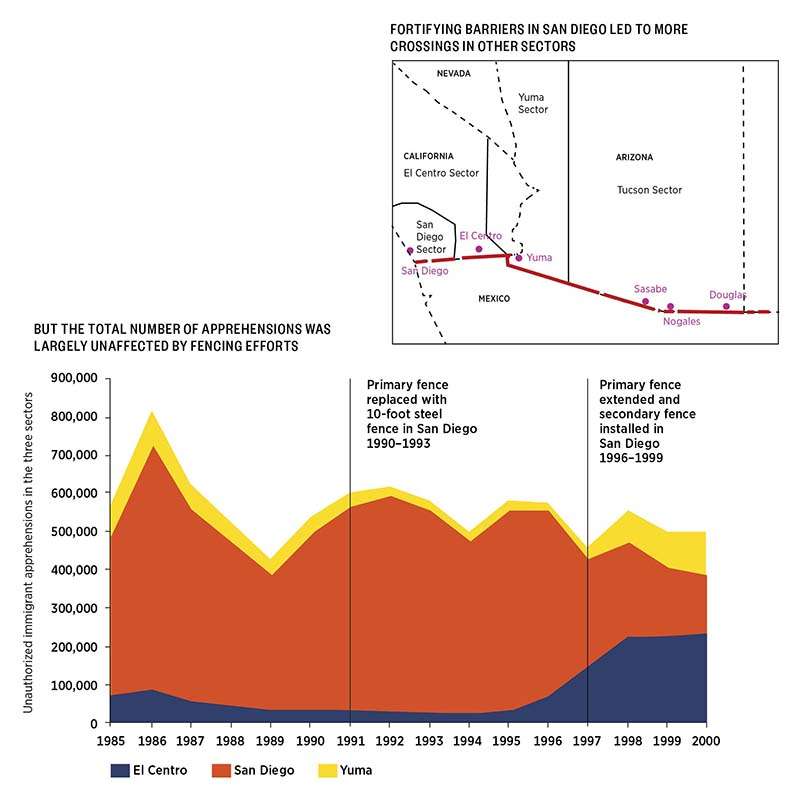
Even if that were to happen, it is simply inaccurate to claim that America's southern neighbor would be paying for the wall, since the revenue would be coming from U.S. consumers. If the United States imposes a tax on Mexican imports, then people in America buying Mexican goods, from beer to cars, will cover it. Sen. Marco Rubio (R–Fla.) said as much to Trump during a presidential primary debate in January 2016, explaining that the Mexican government "doesn't pay the tariff—the buyer pays the tariff." Evidently, the lesson failed to stick.
Trump has also floated the idea of cutting off remittances to Mexico of unauthorized immigrants if the Mexican government refuses to pay up. His proposed regulatory method of doing this (claiming that cash wire transfers are actually bank accounts) is legally suspect, but even if it were licit, it would not cover the cost of the wall. Although Mexican immigrants annually send $26 billion to their families in Mexico, only half of the Mexican immigrants in the United States are here illegally, and the majority of the remittances from unauthorized immigrants would likely find a way home through means other than wire transfers.
The Reason President Trump's wall would be a mammoth expenditure that would have little impact on illegal immigration. But perhaps that's not the point. The campaign's goal was to plant an image in voters' minds of what making America great again would look like. The president's goal may now be to create a symbol, an illustration of a nationalism that says to the world that although people of all kinds may want to come here, America was created by and for Americans.
For those who are not nationalists, the wall is a problem. The direct harms are easy to document: the spending, the taxes, the eminent domain abuse, and the decrease in immigrants' freedom of movement.
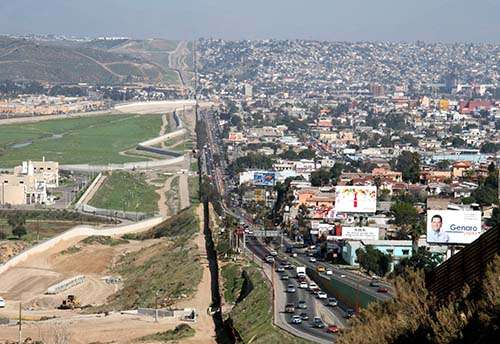
Even if the wall fails to reduce illegal entries significantly overall, one byproduct of making it harder to enter is that people will choose to cross in increasingly dangerous points along the border (the president's "natural barriers"). This objective was a purposeful Border Patrol strategy in the 1990s, and it caused the number of deaths to skyrocket as people perished in mountains or deserts. From 1993 to 2005, the number of lives lost in crossing rose from 23 to 500 per year. Since the border fence was built, the number has declined, but the death rate per crossing had more than tripled by 2012.
Wasteful security has always been the compromise that non-nationalists give to nationalists to obtain a better immigration system, one that treats people humanely and allows more of them to enter and live here legally. The most optimistic case is that the president builds some kind of barrier and takes credit for the drop in illegal immigration that began a decade ago. Seizing victory, he allows some form of immigration reform palatable to moderate Republicans to pass.
But agreeing to the symbol could be seen as conceding the principle behind it. If Trump understands the costs and the limited benefits of the wall, his true purpose may be to force his opponents to give in to the nationalist viewpoint and spend the ensuing decades building and maintaining its outward sign. Many Republicans, including the president, have adopted a "border security first" philosophy that requires certain metrics to be met before other humane reforms take effect, so the wall could simply be an attempt to move the goalposts for security so far that they can never be reached (especially if Mexico's reimbursement is a criterion).
Another possibility is that the wall serves as a grand red herring, forcing Trump's opponents to focus on the symbol while he enforces his true vision in other areas. The president's executive order mandating the construction of a wall also requires a crackdown on asylum seekers coming to the border from Central America. His order on interior enforcement renders nearly all unauthorized immigrants priorities for removal. He has still further orders planned to undermine the legal immigration system for foreign workers. And of course, he has tried to ban all people from seven majority-Muslim countries from entering at all. As his opponents focus on the wall, the Trump administration targets immigrants from every direction.
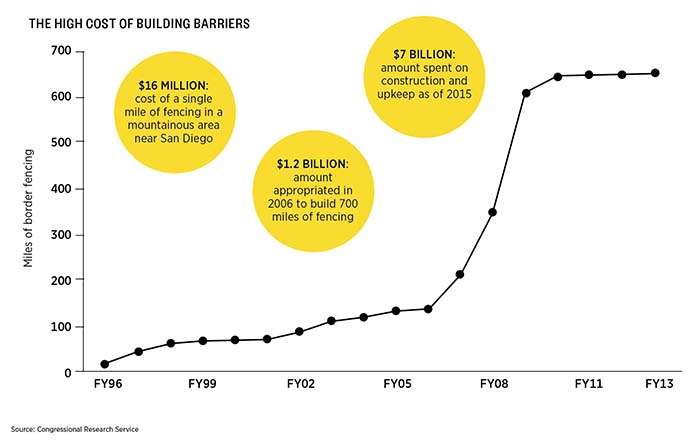
In a sense, the wall merely represents the Trump administration's worst instincts and desires. It is harmful, wasteful, and offensive, but an ineffective wall is nonetheless better than the surge of 5,000 new Border Patrol agents and 10,000 new Immigration and Customs Enforcement officers to round up and deport people that the president also wants. No wall has ever arrested, robbed, battered, or murdered nonviolent people, as immigration enforcement has. A wall will not create an interest group to lobby for itself, endorse nationalist presidential candidates, and demand more power and funding, as the Border Patrol union does.
The wall is more than a symbol. It will harm the lives of thousands of border residents and immigrants while wasting billions of tax dollars. But in a world run by nationalists, the one small source of comfort for non-nationalists over the next four years may be the knowledge that it could be worse.
This article originally appeared in print under the headline "Why the Wall Won't Work."


Show Comments (175)